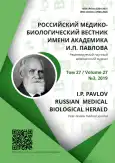P63蛋白质在肺腺癌表达作为不利的因素
- 作者: Byakhova M.M.1,2, Glazkov A.A.1, Vinogradov I.Y.3,4, Frank G.A.2
-
隶属关系:
- M.F. Vladimirsky Moscow Regional Research Clinical Institute
- Russian Medical Academy of Continuous Professional Education
- Ryazan Regional Clinical Oncologic Dispensary
- Ryazan State Medical University
- 期: 卷 27, 编号 3 (2019)
- 页面: 315-324
- 栏目: Original study
- URL: https://bakhtiniada.ru/pavlovj/article/view/16339
- DOI: https://doi.org/10.23888/PAVLOVJ2019273315-324
- ID: 16339
如何引用文章
详细
目的:研究细胞分子生物学标记的光谱,并在其中鉴定出可用作肺腺癌临床病程的预后因素的那些分子标记。
材料与方法:在这项工作中,我们使用了129例确诊为肺腺癌的患者的档案资料。这项工作中采用了组织学、免疫组织化学、分子遗传学和统计学方法。
结果:在29例(47.5%)肺腺癌在不同比例细胞中观察到了p63蛋白的细胞质和/或核心的表达。在p63肿瘤细胞中表达的腺癌患者,无病生存(DFS)平均为25.7±5.1个月,而在无p63表达的患者中,无病生存为26.1±2.8个月。该指标不影响患者的总生存期(OS),平均33.6±2.7个月。
结论:研究中发现,p63阳性肺腺癌患者有轻度降低无复发生存的趋势。肺腺癌中p63表达的检测可认为是预后不良、肿瘤进展较快的因素之一。这需要进行进一步的研究,并提高研究的统计能力。
作者简介
Maria Byakhova
M.F. Vladimirsky Moscow Regional Research Clinical Institute; Russian Medical Academy of Continuous Professional Education
编辑信件的主要联系方式.
Email: biakhovamm@mail.ru
ORCID iD: 0000-0002-5296-0068
SPIN 代码: 2590-6506
Researcher ID: G-4419-2017
MD, PhD, Senior Researcher of the Pathoanatomical Department; Associate Professor of the Department of Pathological Anatomy
俄罗斯联邦, MoscowAlexey Glazkov
M.F. Vladimirsky Moscow Regional Research Clinical Institute
Email: biakhovamm@mail.ru
ORCID iD: 0000-0001-6122-0638
SPIN 代码: 3250-1882
Researcher ID: R-7373-2016
Researcher of the Experimental and Clinical Research Department
俄罗斯联邦, MoscowIgor Vinogradov
Ryazan Regional Clinical Oncologic Dispensary; Ryazan State Medical University
Email: biakhovamm@mail.ru
ORCID iD: 0000-0002-7239-0111
SPIN 代码: 5110-8790
Researcher ID: Q-2281-2019
MD, PhD, Head of the Department of Pathological Anatomy; Senior Researcher of the Central Research Laboratory
俄罗斯联邦, RyazanGeorge Frank
Russian Medical Academy of Continuous Professional Education
Email: biakhovamm@mail.ru
ORCID iD: 0000-0002-3719-5388
SPIN 代码: 9004-4142
Researcher ID: P-1111-2019
MD, PhD, Professor, Academician of the Russian Academy of Sciences, Head of the Department of Pathological Anatomy
俄罗斯联邦, Moscow参考
- Travis WD, Brambilla E, Burke AP, et al. editors. WHO Classification of tumours of the lung, pleura, thymus and heart. 4th ed. Lyon: IARC; 2015.
- Mountzios G, Dimopoulos MA, Soria JC, et al. Histopathologic and genetic alterations as predictors of response to treatment and survival in lung cancer: a review of published data. Critical Reviews Oncology/Hematology. 2010;75(2):94-109. doi:10. 1016/j.critrevonc.2009.10.002
- Langer CJ, Besse B, Gualberto A, et al. The evolving role of histology in the management of advanced non-small-cell lung cancer. Journal of Clinical Oncology. 2010;28(36):5311-20. doi: 10.1200/JCO.2010. 28.8126
- Sinna EA, Ezzat N, Sherif GM. Role of thyroid transcription factor-1 and P63 immunocytochemistry in cytologic typing of non-small cell lung carcinomas. Journal of the Egyptian National Cancer Institute. 2013;25(4):209-18. doi: 10.1016/j.jnci.2013.05.005
- Koh J, Go H, Kim MY, et al. A comprehensive immunohistochemistry algorithm for the histological sub typing of small biopsies obtained from non-small cell lung cancers. Histopathology. 2014; 65(6):868-78. doi: 10.1111/his.12507
- Pelosi G, Rossi G, Bianchi F, et al. Immunohistochemistry by means of widely agreed-upon markers (cytokeratins 5/6 and 7, p63, thyroid transcription factor-1, and vimentin) on small biopsies of non-small cell lung cancer effectively parallels the corresponding profiling and eventual diagnoses on surgical specimens. Journal Thoracic Oncology. 2011;6(6):1039-49. doi: 10.1097/JTO.0b013e3182 11dd16
- Terry J, Leung S, Laskin J, et al. Optimal immu-nohistochemical markers for distinguishing lung adenocarcinomas from squamous cell carcinomas in small tumor samples. American Journal of Surgery Pathology. 2010; 34(12):1805-11. doi:10.1097/ PAS.0b013e3181f7dae3
- Kargi A, Gurel D, Tuna B. The diagnostic value of TTF-1, CK 5/6, and p63 immunostaining in classification of lung carcinomas. Applied Immunohistochemistry & Molecular Morphology. 2007;15(4): 415-20. doi: 10.1097/PAI.0b013e31802fab75
- Nicholson AG, Gonzalez D, Shah P, et al. Refining the diagnosis and EGFR status of non-small cell lung carcinoma in biopsy and cytologic material, using a panel of mucin staining, TTF-1, cytokeratin 5/6, and P63, and EGFR mutation analysis. Journal Thoracic Oncology. 2010;5(4):436-41. doi:10.1097/ JTO.0b013e3181c6ed9b
- Warth A, Muley T, Herpel E, et al. Large-scale comparative analyses of immunomarkers for diagnostic sub typing of non-small-cell lung cancer biopsies. Histopathology. 2012;61(6):1017-25. doi:10.1111/ j.1365-2559.2012.04308.x
- Nobre AR, Albergaria A, Schmitt F. p40: a p63 isoform useful for lung cancer diagnosis – a review of the physiological and pathological role of p63. Acta Cytologica. 2013;57(1):1-8. doi: 10.1159/000345245
- Bir F, Aksoy AA, Satiroglu-Tufan NL, et al. Potential utility of p63 expression in differential diagnosis of non-small-cell lung carcinoma and its effect on prognosis of the disease. Medical Science Monitor. 2014;9(20):219-26. doi: 10.12659/MSM.890394
- Brierley JD, Gospodarowicz MK, Wittekind Chr. TNM Classification of Malignant Tumours. 8th ed. Wiley-Blackwell; 2016.
- Zaridze DG. Carcinogenesis. Moscow; 2004. (In Russ).
- Gonfloni S, Caputo V, Iannizzotto V. P63 in health and cancer. International Journal Developmental Biology. 2015;59(1-3):87-93. doi: 10.1387/ijdb.150045sg
- Adorno M, Cordenonsi M, Montagner M, et al. A Mutant-p53/Smad complex opposes p63 to empower TGFbeta-induced metastasis // Cell. 2009; 137(1):87-98. doi: 10.1016/j.cell.2009.01.039
- Pelosi G, Pasini F, Olsen SC, et al. p63 immunoreactivity in lung cancer: yet another player in the development of squamous cell carcinomas? Journal of Pathology. 2002;198(1):100-9.
- Massion PP, Taflan PM, Jamshedur RSM, et al. Significance of p63 amplification and overexpression in lung cancer development and prognosis. Cancer Research. 2003;63(21):7113-21.
- Wang BY, Gil J, Kaufman D, et al. P63 in pulmonary epithelium, pulmonary squamous neoplasms, and other pulmonary tumors. Human Pathology. 2002;33(9):921-6 doi: 10.1053/hupa.2002.126878
- Iacono M, Monica V, Saviozzi S, et al. p63 and p73 Isoform Expression in Non-small Cell Lung Cancer and Corresponding Morphological Normal Lung Tissue. Journal of Thoracic Oncology. 2011;6(3): 473-81. doi: 10.1097/JTO.0b013e31820b86b0
- Narahashi T, Niki T, Wang T, et al. Cytoplasmic localization of p63 is associated with poor patient survival in lung adenocarcinoma. Histopathology. 2006;49(4):349-57. doi: 10.1111/j.1365-2559.2006. 02507.x
- Ko E, Lee BB, Kim Y, et al. Association of RASSF1A and p63 with poor recurrence-free survival in node-negative stage I-II non-small cell lung cancer. Clinical Cancer Research. 2013;19(5): 1204-12. doi: 10.1158/1078-0432.CCR-12-2848
- Aubry MC, Roden A, Murphy SJ, et al. Chromosomal rearrangements and copy number abnormalities of TP63 correlate with p63 protein expression in lung adenocarcinoma. Modern Pathology. 2015; 28(3):359-66. doi: 10.1038/modpathol.2014.118
补充文件







